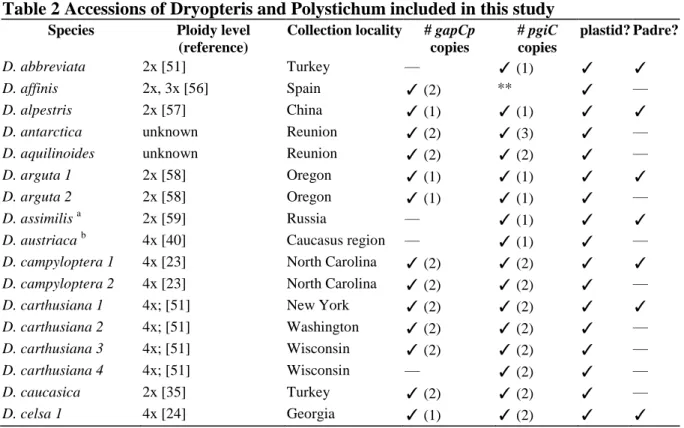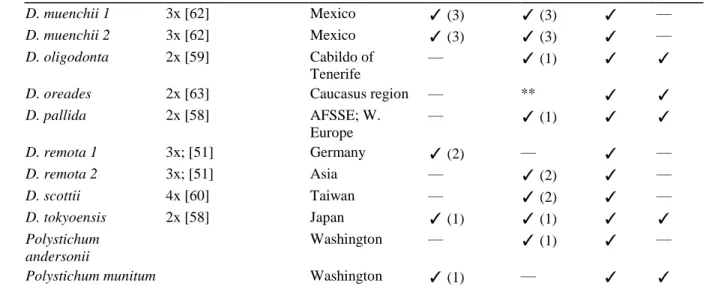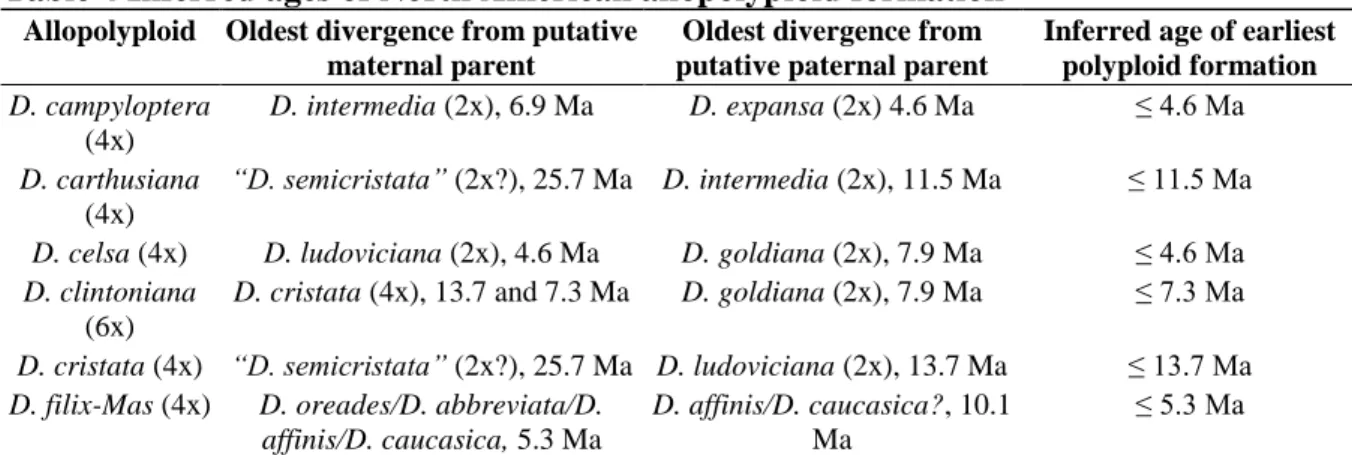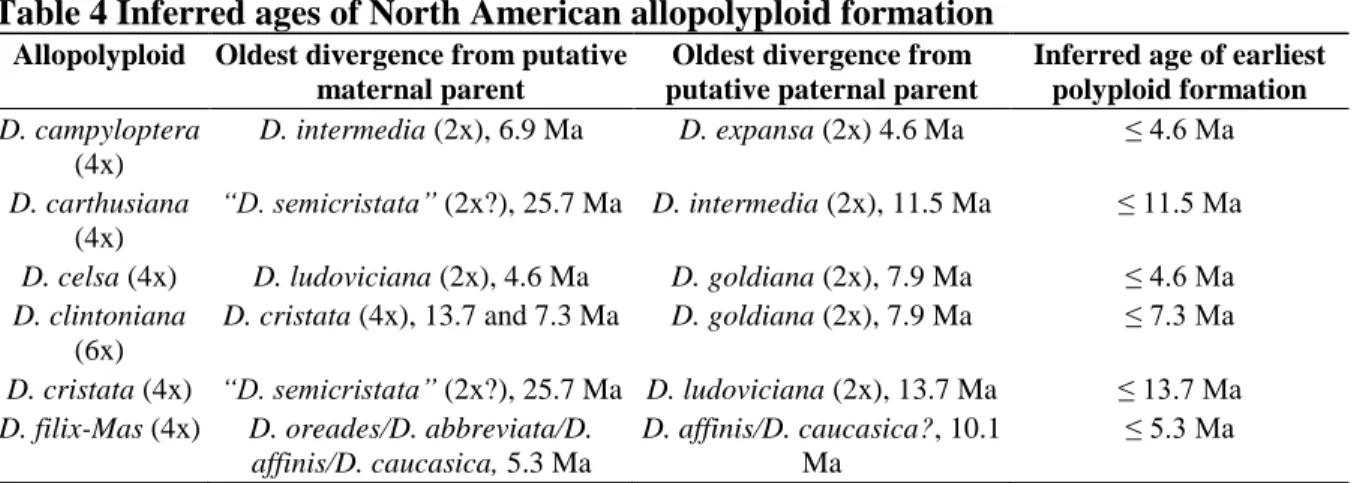Sequences from each of the allopolyploids are most closely related to their progenitor species, as predicted by the 'semicristata' hypothesis. The earliest estimated dates of formation of the allopolyploids, based on divergence time analyses, were within the last 6 million years. This study provides the first in-depth assessment of the North American forest fern complex using comprehensive sampling of taxa and genetic markers.
The base chromosome number in Dryopteris is n = 41 [51] and Walker, in his cytological observations of hybrid D. Plastid sequence data have so far provided support for one of each of the polyploids. Inconsistency length difference (ILD) tests indicated a significant conflict between different regions of the plastid genome (P = 0.01).
Of the 55 Dryopteris accessions in the pgiC dataset, 30 were from species known to be diploid (Table 2), and 27 of these had a single copy of pgiC. As with the plastid phylogeny, much of the lack of resolution involved multiple accessions of one or more species (e.g., clades containing D. carthusiana, D. intermedia, D. . campyloptera, and D. expansa in Fig. 3). For the five polyploid members of the reticulate complex, allopolyploidization events combined the genomes of the inferred progenitor taxa as predicted by "semicristata".
Support for the various relationships from our plastid, nuclear, and reticulation analyzes is summarized and superimposed on a representation of the “semicristata” hypothesis in Figure 6 .
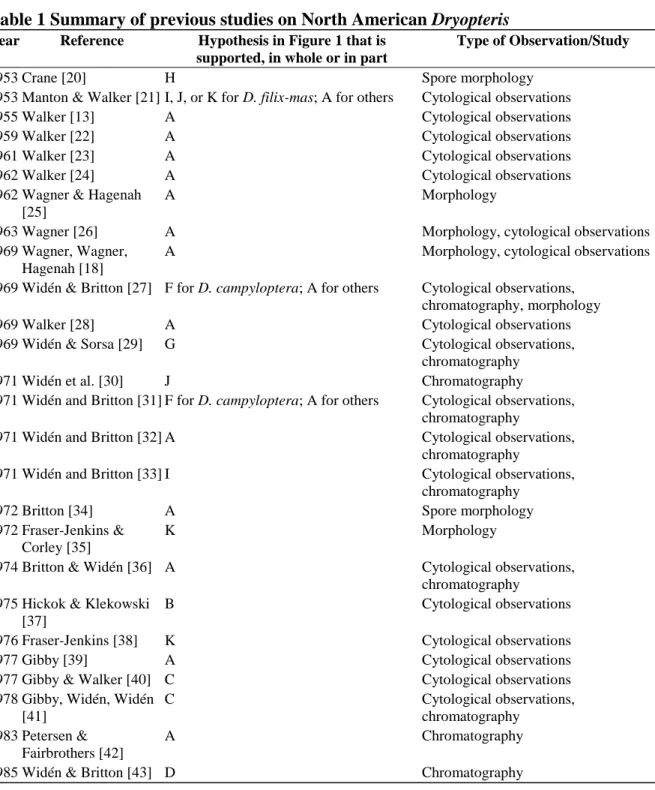
Discussion
The key to unraveling this mystery rests on whether genomes of the three putative descendants of "D. Sequences from each of the allopolyploids clustered together in the plastid phylogeny, with the three putative descendants of "D. For pgiC and gapCp, the expected number of gene copies was found for each of the North American species based on their ploidy (Table 2): diploids had one copy of each marker, tetraploids had two and the hexaploid D.
The second set of homeologs from each of the allotetraploids grouped with their second proposed parent: D. 17] shows that some kind of contamination or PCR error may have been involved in generating the Juslen et al. Previous studies of isozymes and chromatography [42] who demonstrated the additivity of numerous compounds in the North American allotetraploids are also consistent with whole-genome fusion rather than isolated incidents of introgression in the immediate history of the hybrids.
These incongruences between loci and analyzes may reflect one or more of the confluence phenomena mentioned above. Phylogenetic and concordance analyzes [83, 84] preferably of dozens of nuclear markers to determine the dominant history of the nuclear genome should be the next step in assessing relationships between the diploids in this group and determining whether the closest living relative of "D semicristata" is. is D. Recurrent formation of a polyploid occurs when a given species repeatedly arises from separate crosses between different individuals of the same set of parental taxa.
Recurrent origins can be inferred when genetic material from different accessions of a polyploid is more closely related to distinct individuals from one or more of the parental taxa [86], although introgression of markers via backcrossing with a progenitor can also lead to multiple genotypes within a polyploid lineage , which has only had a single origin [92]. Surprisingly, we found no evidence from our sequence data to support multiple origins of any of the North American allopolyploids. For each species, the sequences of A and B (and C, in the case of D. clintoniana) homologues formed groups where all accessions belonged to each other.
For all North American allopolyploids, extensive additional sampling of these species and their progenitors will be essential before repeat formation can be reliably confirmed or ruled out. However, the other allopolyploid parents (D. intermedia and D. ludoviciana) are endemic to North America, suggesting that “D. However, the 95% HPD intervals at each of the corresponding nodes overlap considerably, and the difference in dates does not disprove a North American origin for D .
Conclusions
Interestingly, the geographic ranges of the four North American allotetraploids are transgressive with respect to the ranges of one or both of their parents (i.e., their ranges extend beyond their ancestral range) (Fig. 8A, C, D). However, species pairs in the intermediate or “golden hair” range of divergence would be expected to produce more successful allopolyploid offspring than pairs with low or high levels of divergence due to meiotic incompatibilities in the former and fertilization failure in the latter [99]. , 100]. All thirteen North American species of Dryopteris were included in this study, as well as several species from other regions of the world that were found to be closely related to the North American group based on previous studies [16, 17].
Multiple accessions of all species included in the reticulate complex were included, for a total of 72 accessions representing 35 species (Table 2). We also included an additional pgiC sequence from Dryopteris ludoviciana that was obtained from Genbank and that was the basis for a recent rejection of "D. An unrooted neighbor-joining tree was then constructed for each accession using the remaining sequences and these trees were used in conjunction with visual inspection of the alignments to identify sets of sequences representing distinct homeologs that shared at least three polymorphisms (gaps, single or multiple base pair changes).
Gaps in the alignments due to insertion/deletion events (indels) were coded as present or absent using the method of [108] as implemented in the program FastGap [109], and added to the nucleotide data as additional characters. Incongruence between the data partitions representing different parts of the plastid genome was assessed via the incongruence length difference (ILD) test [ 110 ], implemented as the partition homogeneity test in PAUP*4.0d102 [ 111 ]. The amount of homoplasy in the data was evaluated using consistency indices, both including (CI) and excluding (CI') autapomorphies [119].
These data were not included in the ML and BI analyses, as CIPRES does not provide a way to model standard (non-nucleotide) variables in its analyses. The input data matrix consisted of pgiC and gapCp sequences for one representative each of thirteen North American Dryopteris species and all additional non-network taxa present in our overall data set (i.e. all species of putative diploids that could potentially be progenitors of North American allopolyploids) [95]. As in the mesh network, this included all putative diploid species that could potentially be ancestral to the North American allopolyploids.
All pairwise genetic distances were ranked and a histogram of distances between all diploid pairs was constructed, highlighting those five corresponding to parental pairs that actually produced the North American allopolyploids (for D. clintoniana the putative paternal progenitor is D. goldiana; .. the presumed maternal parents are D. cristata, which itself is an allotetraploid whose presumed maternal parent is "D. semicristata", so D. goldiana – "D. semicristata" was considered the parent pair for D. clintoniana). A randomization test with 10,000 replications was performed determining whether the sum of squared deviations from the mean (the overall mean of genetic distances for all pairs, equal to 0.0358) of the five parent pairs matched to the true allopolyploids was significantly less than the random expectation. Significance (P <. 0.05) was considered strong evidence for the "intermediate" nature of the genetic distances between parental pairs of the true allopolyploids, in that in less than 5% of cases a random set of five parental pair distances would have a smaller sum of squared deviations from the mean as the set that gave rise to the five actual allopolyploids.
Competing interests
Authors’ contributions
Acknowledgements
Werth CR, Guttman SI, Eshbaugh WH: Electrophoretic evidence for reticulate evolution in the Appalachian Asplenium complex. Beck J, Windham MD, Yatskievych G, Pryer KM: A diploid-first approach to species delimitation and the interpretation of polyploid evolution in the fern genus Astrolepis (Pteridaceae). Wagner WH: Pteridophytes of the Mountain Lake area, Giles County, Virginia, including notes from Whitetop Mountain.
Fraser-Jenkins CR, Corley HV: Dryopteris caucasica - an ancestral diploid in the male fern aggregate. Gibby M, Walker S: Further cytogenetic studies and a reappraisal of the diploid ancestry in the Dryopteris carthusiana complex. Werth CR: Isozyme research on the Dryopteris “spinulosa” complex, I: The origin of the tree trunk fern Dryopteris celsa.
Vogel JC, Russell SJ, Rumsey FJ, Barrett JA, Gibby M: Evidence for maternal transmission of chloroplast DNA in the genus Asplenium (Aspleniaceae, Pteridophyta). Fraser-Jenkins CR: Dryopteris affinis: A new treatment for a complex species in the European pteridophyte flora. Hoshizaki BJ, Wilson KA: Cultivated species of the fern genus Dryopteris in the United States.
Gibby M, Jermy AC, Rasbach H, Rasbach K, Reichstein T, Vida G: The genus Dryopteris in the Canary Islands and Azores and the description of two new tetraploid species. Gibby M: Hybridization and speciation in the genus Dryopteris (Pteridophyta: . Dryotperidaceae) on Pico Island in the Azores. Molecular phylogeny of the fern genus Elaphoglossum (Elaphoglossaceae) based on chloroplast non-coding DNA sequences: contributions from species from the Indian Ocean area.
Soltis DE, Soltis PS, Tate JA: Advances in the study of polyploidy since plant speciation. Hunt HV, Ansell SW, Russell SJ, Schneider H, Vogel JC: Dynamics of polyploid formation and establishment in the allotetraploid rock fern Asplenium majoricum. BC Man: The role of triploid hybrids in the evolutionary dynamics of mixed-ploidy populations.
Liu HM, Zhang XC, Wang W, Qiu YL, Chen ZD: Molecular phylogeny of the fern family Dryopteridaceae Inferred from chloroplast rbcL and atpB genes. Grusz AL, Windham MD, Pryer KM: Deciphering the origin of apomictic polyploids in the Cheilanthes yavapensis complex (Pteridaceae).
Additional file
Testing the impact of calibrating molecular divergence times using a fossil-rich group: the case of Nothofagus (Fagales). Ho SYW, Phillips MJ: Accounting for calibration uncertainty in phylogenetic estimation of evolutionary divergence times.

